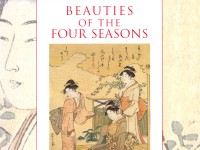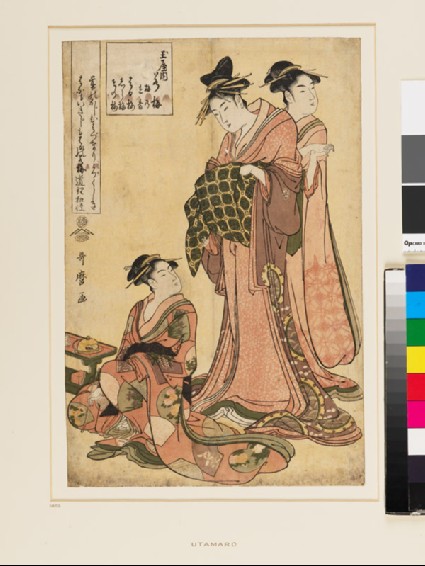Beauties of the Four Seasons
A full catalogue of the Ashmolean’s collection of Japanese bijinga (beautiful women) prints by Mitsuko Watanabe (published Oxford, 2005).

Publications online: 54 objects
The Courtesan Wakaume of the Tamaya
-
Literature notes
The Courtesan Wakaume of the House of Tama-ya with a shinzō behind her, looks down at the other shinzō sitting beside a tobacco cabinet. According to Yoshiwara Saiken (the Guide Book of Yoshiwara), Wakaume belonged to the House of Tama-ya from 1788 to 1798. Her soft and graceful face was much admired and was often depicted by Ukiyo-e artists. The inscription mentions the 'haru no wakaume' ('young plum tree of the spring'), an obvious pun, and 'uguisu' ('Japanese bush warbler') which both imply the coming of spring.
The print retains much of its original colouring. -
Details
- Associated place
- Date
- c. 1800
- Artist/maker
-
Kitagawa Utamaro (c. 1753 - 1806) (designer)Fujiwara no Teika (1162 - 1241) (author)
- Associated people
-
Tsutaya Jūzaburō (1774 - 1852) (publisher)Tamaya Wakaume (late 18th century - early 19th century) (subject)Haruume (late 18th century - early 19th century) (subject)Shiraume (late 18th century - early 19th century) (subject)
- Material and technique
- nishiki-e (multi-block) woodblock print, printed with water-based vegetable pigments
- Dimensions
-
mount 55.5 x 40.5 cm (height x width)
print 37.2 x 25 cm (height x width)
- Material index
- Technique index
- Object type index
- No. of items
- 1
- Credit line
- Presented by Mrs Allan and Mr and Mrs H. N. Spalding, 1952.
- Accession no.
- EAX.4113
-
Further reading
Oxford: Ashmolean Museum, 24 August-30 November 2005, Beauties of the Four Seasons, Mitsuko Watanabe, ed. (Oxford: Ashmolean Museum, 2005), no. 11 on p. 22, p. ix, illus. p. 23
Glossary (2)
nishiki-e, vegetable pigments
-
nishiki-e
Nishiki-e literally means 'brocade pictures' and refers to multi-coloured woodblock prints.
-
vegetable pigments
Vegetable pigments were used to create coloured dyes for Japanese prints, paintings, and textiles. These pigments often faded over time due to the chemical reactions they underwent.
Location
-
- currently in research collection
Objects are sometimes moved to a different location. Our object location data is usually updated on a monthly basis. Contact the Jameel Study Centre if you are planning to visit the museum to see a particular object on display, or would like to arrange an appointment to see an object in our reserve collections.
Publications online
-

Beauties of the Four Seasons
The Courtesan Wakaume of the House of Tama-ya with a shinzō behind her, looks down at the other shinzō sitting beside a tobacco cabinet. According to Yoshiwara Saiken (the Guide Book of Yoshiwara), Wakaume belonged to the House of Tama-ya from 1788 to 1798. Her soft and graceful face was much admired and was often depicted by Ukiyo-e artists. The inscription mentions the 'haru no wakaume' ('young plum tree of the spring'), an obvious pun, and 'uguisu' ('Japanese bush warbler') which both imply the coming of spring.
The print retains much of its original colouring. -

Beauties of the Four Seasons
The Courtesan Wakaume of the House of Tama-ya with a shinzō behind her, looks down at the other shinzō sitting beside a tobacco cabinet. According to Yoshiwara Saiken (the Guide Book of Yoshiwara), Wakaume belonged to the House of Tama-ya from 1788 to 1798. Her soft and graceful face was much admired and was often depicted by Ukiyo-e artists. The inscription mentions the 'haru no wakaume' ('young plum tree of the spring'), an obvious pun, and 'uguisu' ('Japanese bush warbler') which both imply the coming of spring.
The print retains much of its original colouring.
Notice
Object information may not accurately reflect the actual contents of the original publication, since our online objects contain current information held in our collections database. Click on 'buy this publication' to purchase printed versions of our online publications, where available, or contact the Jameel Study Centre to arrange access to books on our collections that are now out of print.
© 2013 University of Oxford - Ashmolean Museum

